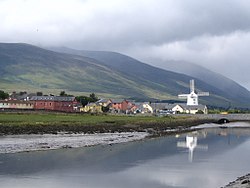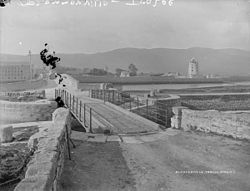Blennerville
| Blennerville Irish: Cathair Uí Mhóráin | |
| County Kerry | |
|---|---|

| |
| Location | |
| Grid reference: | Q812130 |
| Location: | 52°15’22"N, 9°44’10"W |
| Data | |
| Population: | 141 (2011) |
| Local Government | |
Blennerville is a small village near Tralee, County Kerry, a mile west of the town centre on the N86 road to Dingle, where the River Lee enters Tralee Bay.
The village was formerly Tralee's port, and is connected to the town centre by the Tralee Ship Canal.[1]
The name in Irish is Cathair Uí Mhóráin, meaning "seat/home of the Morans".[2]
History
Blennerville was originally called 'Cahermoraun' or 'Cahirmoreaun',[3] and it has been speculated that it was the ancient site of the Tramore ford, the only escape route afforded to the 15th Earl of Desmond from Tralee towards the south, before his capture and execution in 1583.[3]
Whether the old Tramore ford was at the spot where the bridge has been erected, or on the firmer sands further down towards Tralee Spa, is not certain, but the ancient name of Blennerville, (before Sir Rowland Blennerhassett, 1st Baronet made it his residence and elevated it into a village after his name,) being Cahirmoreaun i.e. the cahir on the great river, renders it probable that the passage was there, and that a ferry house or some such place was the nucleus round which the hamlet originally grew.— A. B. Rowan, The Last Geraldyn Chief of Tralee Castle[3]
A bridge was built at the site in 1751, and in 1783 Sir Rowland Blennerhassett renamed it Blennerville after his family. Blennerville Windmill, Ireland's only commercially operating windmill, was built in 1800. The port at Blennerville was used through most of the 19th century as a gateway from Kerry to North America by emigrants wishing to cross the Atlantic Ocean. The Jeanie Johnston was the most famous of these ships that transported emigrants, and throughout its service no passenger ever died.
By 1846, however, the Tralee Ship Canal was opened, replacing Blennerville as Tralee's port and the village went into decline with the windmill falling into ruins and closing by the mid-19th century.
In 1891 the Tralee and Dingle Light Railway opened connecting Tralee with Dingle along the most western railway line in the British Isles at the time. A station operated at Blennerville until the line closed in 1953. Blennerville National School was built in 1932.
Recent times
In 1981 Blennerville Windmill was purchased by Tralee Urban District Council; restoration work began in June 1984 before the windmill was opened to the public in 1990. It is now impressively restored and open to the public with a visitor centre comprising a craft centre, exhibition gallery, audio-visual presentation and restaurant.
A restoration project of the Tralee and Dingle Light Railway was undertaken in 1993 with a short two-mile replica of the original line opened between the Aquadome in Tralee to the restored station at Blennerville. As of 2014 the railway is no longer in operation. Blennerville Bridge was strengthened and enlarged in 1996.
In the late 1980s an idea was conceived of building a replica of the Jeanie Johnston ship that sailed from Blennerville to North America during the 19th century. It did not become a reality until November 1993 when a feasibility study was completed, and in May 1995 The Jeanie Johnston (Ireland) Company Ltd. was incorporated. The Jeanie Johnston was constructed in a shipyard located only yards from where she sailed from Blennerville's original port. It was originally planned to launch the ship from her shipyard in Blennerville, but a 19th-century shipwreck was discovered by marine archaeologists while a channel was being dredged. To preserve the find, on 19 April 2000 the hull of the Jeanie Johnston was hauled to the shore and loaded onto a shallow-draft barge. There she was fitted with masts and sails, and on 4 May was transported to Fenit, a short distance away. On 6 May the barge was submerged and the Jeanie Johnston took to the water for the first time. Today the Jeanie Johnston is owned by the Dublin Docklands Development Authority and is located in Dublin.[4]
Outside links
References
- ↑ "Strategic Environmental Assessment", Tralee Town Development Plan (Tralee Town Council), 2009
- ↑ @: Placenames Database of Ireland
- ↑ 3.0 3.1 3.2 Rowan, A. B. (1872). "The Last Geraldyn Chief of Tralee Castle". in Hickson, Mary Agnes. Selections from Old Kerry Records; Historical and Genealogical. London: Watson & Hazell. p. 125. https://archive.org/stream/selectionsfromol00hick#page/n263/mode/2up. Retrieved 2011-10-25.
Originally published Kerry Magazine. May 1854. - ↑ "Famine Ship Museum Jeanie Johnston". Dublin City Council. https://www.dublindocklands.ie/visiting-docklands/things-do/sightseeing/famine-ship-museum-jeanie-johnston-0.
